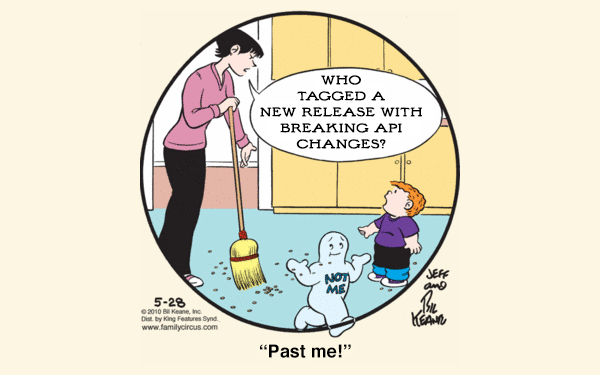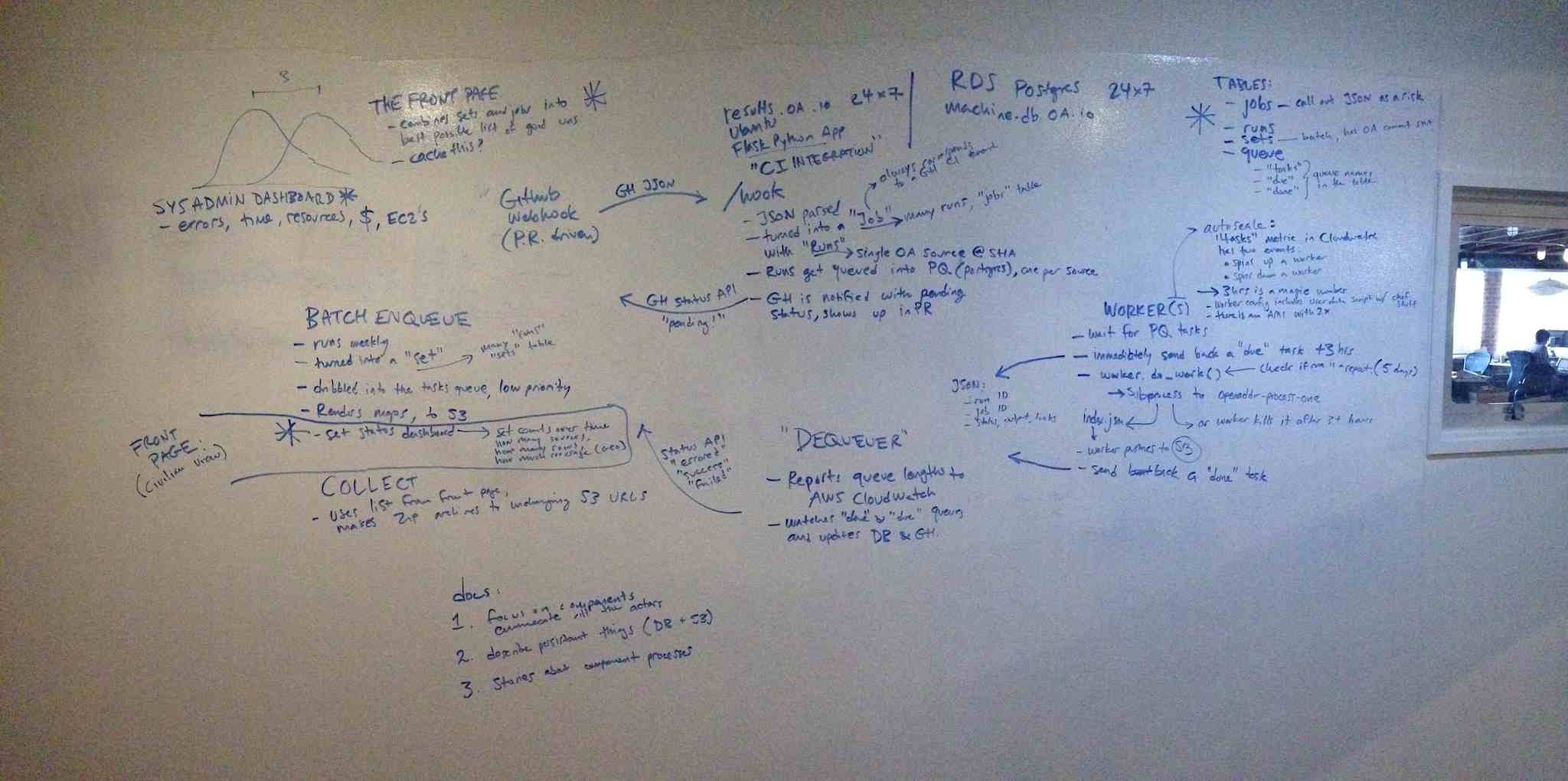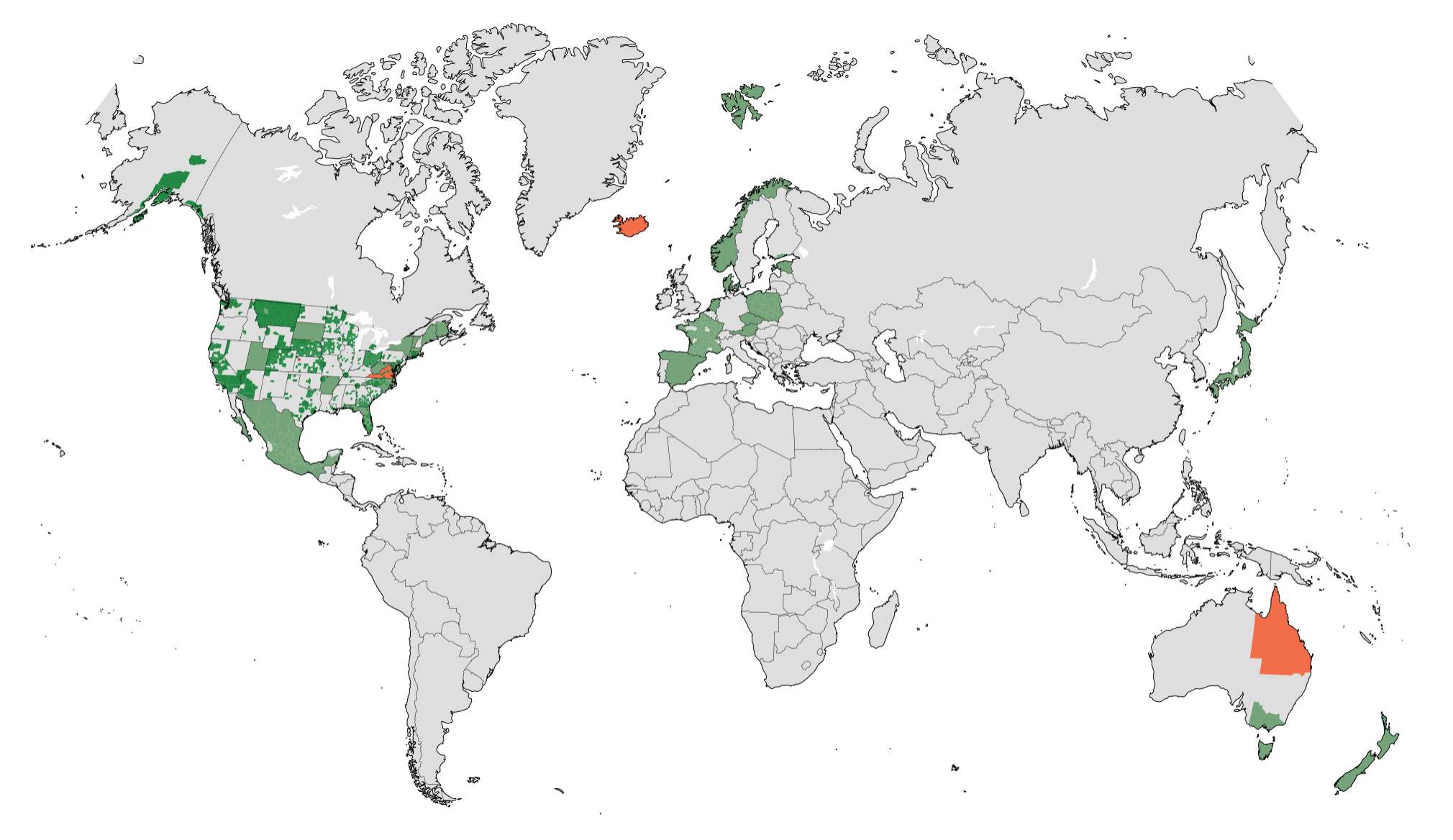tecznotes
Michal Migurski's notebook, listening post, and soapbox. Subscribe to ![]() this blog.
Check out the rest of my site as well.
this blog.
Check out the rest of my site as well.
Nov 2, 2015 12:18am
code like you don’t have the time
I’m in management these days, and I’m still an active developer of open source projects. I enjoy code, I want to keep my hands in open data initiatives like OpenAddresses, I value a connection to current practice, but it’s a way of spending time that competes directly with Day Job.
I’ve been working on a set of choices that make it possible to advance an open source software project in small, manageable increments, based around three values: predictability, accessibility, and repeatability.
My primary evenings-and-weekends project these days is OpenAddresses and the Machine repository that processes the data. My first commit to Machine was almost a full year ago, and it’s been evolving ever since despite being in continual contention with all the other evening-and-weekend responsibilities I have to my life and health away from the keyboard. At any given moment, development might be interrupted by dinner, a movie, a night out, or a long bike ride. This is a catalog of the tools and practices I’m using to make it possible to work on OA long-term, using time and energy sustainably along the way.
Easy To Predict
Semantic Versioning (Semver) is a requirement for any open source code project.
Under this scheme, version numbers and the way they change convey meaning about the underlying code and what has been modified from one version to the next. … Software using Semantic Versioning MUST declare a public API. This API could be declared in the code itself or exist strictly in documentation. However it is done, it should be precise and comprehensive. A normal version number MUST take the form X.Y.Z where X, Y, and Z are non-negative integers, and MUST NOT contain leading zeroes. X is the major version, Y is the minor version, and Z is the patch version. (Tom Preston-Werner)
Semver is not to be confused with Sentimental Versioning: “You may explain the system you create, if the beauty is enhanced by understanding it. You may just improvise new numbers from your mood on that day. The only important thing, is that the version number must be meaningful to you, the author.” The documentation clause of Semver requires that a public API be specified for the version numbers to mean anything. It’s a way of making and keeping promises to collaborators such as your bigger, meaner, future self.
If a project is anything other than a library of code, such as a website, a running service, or a specification, it becomes important to coordinate changes in a stable way. OpenAddresses is all of those things. Take this ticket from the Ops repository as an example: it’s a proposal to modify the data source syntax, which will impact both the code that processes OA data sources and the documentation in the sources repository. To maintain continuous stability over the lifetime of this change, each move needs to be small and atomic, able to be interrupted at any moment for any reason.
- Get input in Ops so we know we’re making a good choice.
- Pick a small part of the work to implement and deploy.
- Modify the Machine code so it supports the new behavior without breaking support for the old.
- Deploy changes to any running instance.
- Document the new behavior publicly, once it’s deployed and reflects reality.
I’m on a flight right now, so the last step above could be interrupted by turbulence or failed #planeclub wi-fi. The steps are in place to brace against instability. The image of coordination I try to keep in mind is crossing a river over a series of stepping stones: regain balance at each step, and never fall in when the wind kicks up.
(Secret Service agents bracing themselves against helicopter prop wash)
Easy To Access
To ensure your work is accessible, you need documentation, you need eyes on that documentation, and you need software unit and integration tests on everything.
It's called Accessibility, and it's the most important thing in the computing world. The. Most. Important. Thing. … When software—or idea-ware for that matter—fails to be accessible to anyone for any reason, it is the fault of the software or of the messaging of the idea. It is an Accessibility failure. (Steve Yegge)
To make the Machine accessible to new contributors, we worked out a high-level set of documents that focus on four main areas: moving pieces like commands and scripts, persistent things like datastores, processes like the lifecycle of test jobs, and externalities like Amazon Web Services account information. This is the result, and this is where the work happened. Everything is cross-referenced and linked to source code, and I’ve attempted to ensure that everything can be linked with a stable URL.
So much of Machine lives in my head that I reached out to Nelson Minar for help. We set up a sort of interrogation, where I attempted to draw everything, he poked at my drawing with questions, and we added and removed detail until it made sense. Nelson recommended the four-part focus on components, processes, storage, and externals above, and the work is in this thread. The docs are not auto-generated. Even on older projects like TileStache, we wrote human documentation defining the API for Semver purposes that’s separate from machine documentation enumerating the code. They serve different purposes.
Tests are the other critical piece of this puzzle. In dynamic languages like Python, tests fill a need that overlaps with static types in other languages—they help ensure that a method does what it’s supposed to do, and back-fill the clarity exiled by rigid DRY. Machine is covered by bucketloads of tests, and I’ve been slowly improving my instincts for good unit tests as I’ve worked.
Easy To Repeat
Andy Allan’s 2012 post about getting started with Chef hooked me on using it for configuration management, for this reason:
Configuration management really kicks in to its own when you have dozens of servers, but how few are too few to be worth the hassle? It’s a tough one. Nowadays I’d say if you have only one server it’s still worth it–just–since one server really means three, right? The one you’re running, the VM on your laptop that you’re messing around with for the next big software upgrade, and the next one you haven’t installed yet. (Any Allan)
Previously, I’d always used shell scripts to configure services. Chef can be used the same way, with the key difference that a Chef recipe/cookbook/whatever defines an end-state rather than a process. It will “converge” the state of your system, taking whatever actions are needed to adjust it to match the declared intent (using a tedious, cringeworthy metaphor-cloud of kitchen words). In OpenAddresses, we have a few example pieces of Chef use:
- Complete cookbooks and recipes in the chef directory.
- A run script to call instead of chef-solo commands.
- Role files like this one where configuration details end up.
- Recipes consisting of resources such as this simple one.
At this point, I will probably never again run a server without involving configuration management in some form. The converge concept is too much of an improvement over simple bash scripts to ignore. If you’ve already started from a bash script, try adapting this simple base chef configuration with its one weird recipe. You don’t need to install a Chef server, or do any of the other crazy multi-machine fleet things either; chef-solo alone provides much of the benefit.
Lastly, it’s important to repeatability that your environment doesn’t slip around too much while you’re off doing something else. If months or years might pass between opportunities to devote significant time to a project, you don’t want your welcome back to be a continual module update juggling act. For this reason, stick to a language’s standard library wherever possible. Python advertises itself as “batteries included,” which will often rescue you from unpredictably changing requirements. Your code is the interesting part; rely only on modules outside a standard library if they’re stable, provide significant functionality, and themselves comply with Semver. At the system level, try to rely on package managers like Debian’s Apt and look for signs of stability in system releases such as Ubuntu’s Long-Term Support concept. Packaging is hard, espeically if you’re reliant on someone upstream from you doing it right:
I am not at all happy with the one package manager per programming language situation. I am old and crotchety and I’m tired of how every programming language keeps rediscovering just how fucking hard packaging and software distribution is. It really deserves to be elevated to hardest problem in computer science, ahead of cache invalidation and naming things. (JordiGH comments on Kevin Burke)
Conclusion
These practices and tools have made it possible to make steady, incremental progress on OpenAddresses with a group of collaborators over the past year. I’ve kept the work predictable, accessible, and repeatable. Even though Machine’s bus number is still close to 1, I’ve tried to keep the bus moving so slowly that it poses less of a risk while keeping the excitement focused on the 213m+ addresses we’ve managed to collect.




Comments
Sorry, no new comments on old posts.